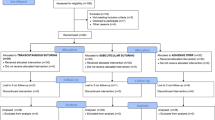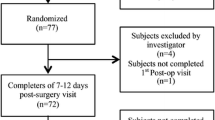Abstract
Cyanoacrylate adhesives offer the surgeon and patient an alternative to subcuticular suturing. LiquiBand® Surgical S (LBSS) is a new formulation with a blend of monomeric n-butyl and 2-octyl cyanoacrylates. In this study, the effectiveness, safety, and clinical utility of LBSS was compared to Vicryl™ sutures for the closure of laparoscopic incisions. This was a prospective randomized study of LBSS skin adhesive versus Vicryl™ sutures for the topical closure of laparoscopic surgical incisions. Subjects were asked to return at 2 weeks postsurgery to report complications and adverse events. Wounds were evaluated for apposition and cosmesis using a modified Hollander Wound Evaluation Scale (HWES). The Shapiro–Wilk test of normality was done. Independent-samples T test, Mann Whitney U test, and chi-square test were used to compare variables between the two wound closure methods. A total of 114 subjects participated in this trial completing all aspects of the study. Fifty-five subjects received sutures for topical wound closure, with 59 subjects receiving LBSS. Surgeons were found to be satisfied with 100 % of all applications using the LBSS device. One hundred percent of wounds closed with sutures and 98.9 % wounds closed with LBSS achieving an optimal HWES of 0. There was no statistical difference in cosmesis or complications for either method. Closure with LBSS was significantly faster by a mean of 2 min. LiquiBand® Surgical S is as good as sutures for the closure of laparoscopic wounds in terms of cosmesis and complications with the added benefit of being significantly faster.


Similar content being viewed by others
References
Majno G (1975) The healing hand: man and wound in the ancient world, 1st edn. Harvard University Press, Cambridge, MA
Coulthard P, Esposito M, Worthington HV, van der Elst M, van Waes OJF, Darcey J (2010) Tissue adhesives for closure of surgical incisions. Cochrane Database Syst Rev CD004287
Farion K, Osmond MH, Hartling L, Russell K, Klassen T, Crumley E, Wiebe N (2002) Tissue adhesives for traumatic lacerations in children and adults. Cochrane Database Syst Rev CD003326
Chow A, Marshall H, Zacharakis E, Paraskeva P, Purkayastha S (2010) Use of tissue glue for surgical incision closure: a systematic review and meta-analysis of randomized controlled trials. J Am Coll Surg 211:114–125
Tajirian AL, Goldberg DJ (2010) A review of sutures and other skin closure materials. J Cosmet Laser Ther 12:296–302
Hollander JE, Singer AJ, Valentine S, Henry MC (1995) Wound registry: development and validation. Ann Emerg Med 25:675–685
Penoff J (1999) Skin closures using cyanoacrylate tissue adhesives. Plastic Surgery Educational Foundation DATA Committee. Device and Technique Assessment. Plast Reconstr Surg 103:730–731
Romero P, Frongia G, Wingerter S, Holland-Cunz S (2011) Prospective, randomized, controlled trial comparing a tissue adhesive (Dermabond™) with adhesive strips (Steri-Strips™) for the closure of laparoscopic trocar wounds in children. Eur J Pediatr Surg 21:159–162
Jallali N, Haji A, Watson CJE (2004) A prospective randomized trial comparing 2-octyl cyanoacrylate to conventional suturing in closure of laparoscopic cholecystectomy incisions. J Laparoendosc Adv Surg Tech A 14:209–211
Sebesta MJ, Bishoff JT (2004) Octylcyanoacrylate skin closure in laparoscopy. JSLS 8:9–14
Matin SF (2003) Prospective randomized trial of skin adhesive versus sutures for closure of 217 laparoscopic port-site incisions. J Am Coll Surg 196:845–853
Maartense S, Bemelman WA, Dunker MS, de Lint C, Pierik EGJM, Busch ORC, Gouma DJ (2002) Randomized study of the effectiveness of closing laparoscopic trocar wounds with octylcyanoacrylate, adhesive papertape or poliglecaprone. Br J Surg 89:1370–1375
Dowson CC, Gilliam AD, Speake WJ, Lobo DN, Beckingham IJ (2006) A prospective, randomized controlled trial comparing n-butyl cyanoacrylate tissue adhesive (LiquiBand) with sutures for skin closure after laparoscopic general surgical procedures. Surg Laparosc Endosc Percutan Tech 16:146–150
Ciechanowicz S, Wilson N (2011) Delays to operating theatre lists: observations from a UK centre. IJH. doi:10.5580/e82
Osmond MH, Klassen TP, Quinn JV (1995) Economic comparison of a tissue adhesive and suturing in the repair of pediatric facial lacerations. J Pediatr 126:892–895
Singer AJ, Quinn JV, Hollander JE (2008) The cyanoacrylate topical skin adhesives. Am J Emerg Med 26:490–496
Rosin D, Rosenthal RJ, Kuriansky J, Brasesco O, Shabtai M, Ayalon A (2001) Closure of laparoscopic trocar site wounds with cyanoacrylate tissue glue: a simple technical solution. J Laparoendosc Adv Surg Tech A 11:157–159
Conflict of interest
Funding of the study was provided by Advanced Medical Solutions (Plymouth) Ltd. Western Wood Way, Langage Science Park, Plympton, Plymouth, Devon PL7 5BG, England. Advanced Medical Solutions (Plymouth) Ltd funded the presentation of the paper at a national conference. The authors report no other conflicts of interest.
Author information
Authors and Affiliations
Corresponding author
Rights and permissions
About this article
Cite this article
Jan, H., Waters, N., Haines, P. et al. LiquiBand® Surgical S topical adhesive versus sutures for the closure of laparoscopic wounds. A randomized controlled trial. Gynecol Surg 10, 247–252 (2013). https://doi.org/10.1007/s10397-013-0805-5
Received:
Accepted:
Published:
Issue Date:
DOI: https://doi.org/10.1007/s10397-013-0805-5




